Hooray you sexy readers! How are you? This time I'd like to bring a travel story with some history inside.
As I usually say on my posts, travelling without learning about the place you go, is not travelling, is tourism. It's like watching about all those amazing places through television, where generally they give misinformation - That all makes us experts of what we don't really know.
This is not a critic to television in specific, nor I want to bash those who are not really interested on historic facts. It's only me taking out some feelings out of my chest, as this post will not only contain another awesome hitchhiking trip, but it'll also bring a tiny dab of sad history.
Let's not get too far into this introduction, as I don't want to over extend on the reading. However, I cannot pass without mentioning my dear friend @riverflows for bringing awarness to the aboriginal history and the importance of spreading their true history.
This post will talk about my passage through some important places in Patagonia before reaching Tierra del Fuego. There I've learned the true and sad history of that place and what was done to the original inhabitants of those cold lands. I'd like to apologize in advance for the lack of images or breathtaking views on this post, all I want is that you value the written history. Enjoy!

Click image to enlarge!
Obs.: This story is part of a bigger journey that I plan to tell you one day. Since it would be incredibly long I've decided to release parts of it, featuring the most crazy bits. It'll not follow an order of events, but I'll put it in a way that you can read as parts of a book. Hope you enjoy.
This happened when I was hitchhiking Argentina and Chile in summer 2017. Carrying only the essentials and little money for the journey. I had left Buenos Aires in early January with the main goal to reach Ushuaia, the southernmost city in the americas. Plan was plain an simple: Work if needed, camp, hitchhike all the way, have loads of fun and let my desire guide the way.
January 6th, 2017. It was cold and gray when I woke up mid morning in that parking lot, still exhausted, with the noise of the trucks passing by. I was feeling weak and worried with a constipation that was ravaging me for the last days. After four days on the road my body was still in the process of adapting to the new routine and the bad diet was not helping. I had not yet had time to prepare and organize the travel meals, which so far were based on sweet biscuits with Mate. With a hard effort I disassembled my tent, put on my backpacks and left my free camping site.
My plan that day was to leave the city of Rio Gallegos in Argentina and continue my journey towards south heading to my main objective, Ushuaia. It was simple and quick; take care of mourning routines and find a ride. The first plan worked out like a charm and even my guts decided to work. Finding a ride became a journey of itself, but I finally found one with a nice guy called Eduardo. This guy needs a story telling just for himself, as I've learned some lessons travelling with him, but let's keep that for later and jump straight to the subject of this post or it would become gigantic.
Eduardo agreed to give me a ride from Rio Gallegos to Punta Arenas, one of the access points to the island of Tierra del Fuego. The trip between Rio Gallegos and Punta Arenas covers about 300 km, a particularly cold, windy and beautiful route. Going down Route 3, south of Rio Gallegos, we successfully entered Chile, it was my first time in this country that I've always planned to visit. I was excited. To the left we were bordering the Strait of Magellan, which boasted its turbulent green waters, which were strongly hitting the coast. Now I could understand the difficulty of navigating these icy seas, the wind was intense and sometimes it tried to take the vehicle off course.
A few miles ahead a place particularly caught my eyes, the Estancia San Gregorio, founded at the end of the 19th century by the landowner José Menendez.
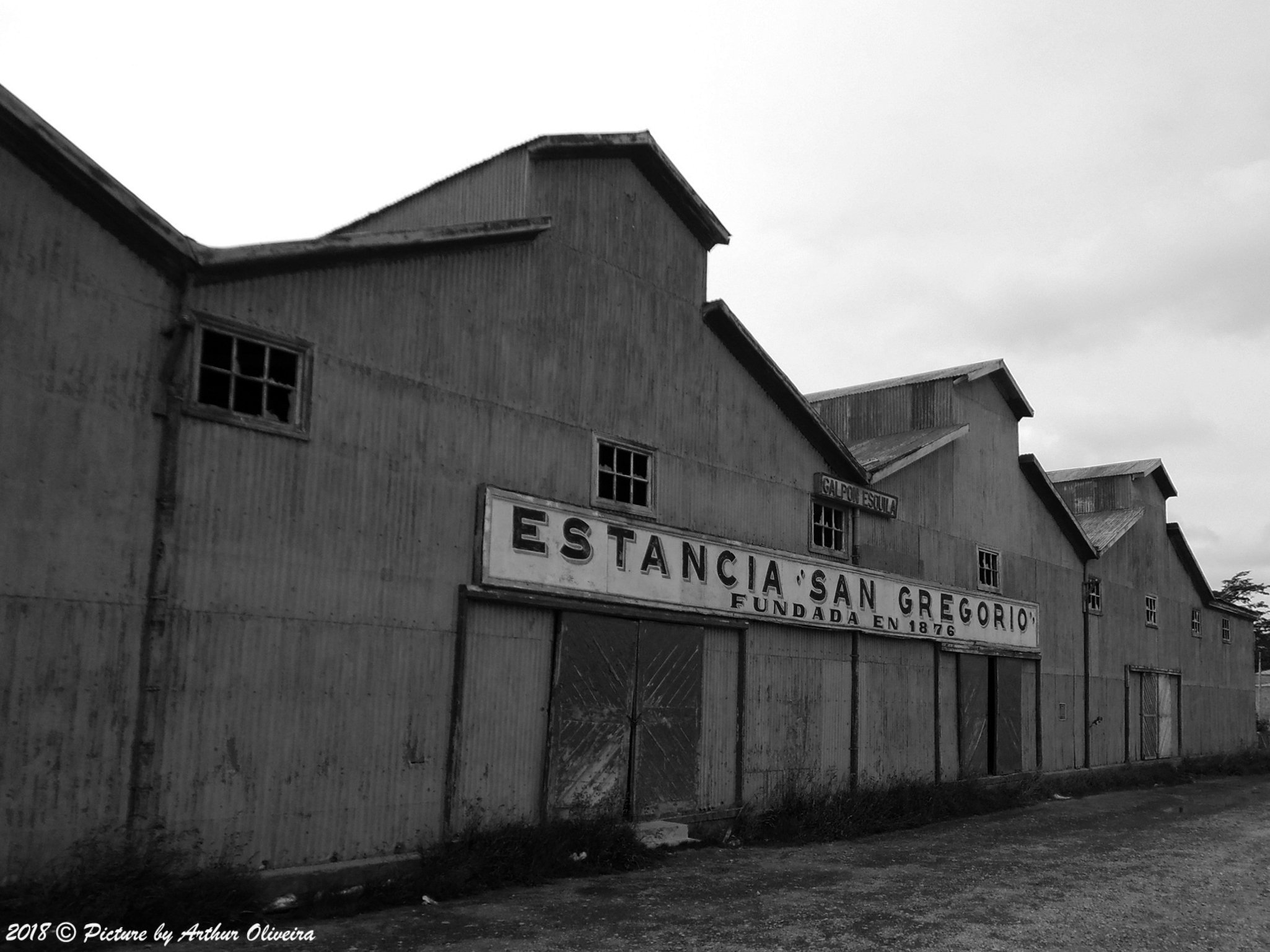
Click image to enlarge!
Once, this farm was the pioneer in the agroindustrial production on the austral region, considered at the time one of the most well constructed and with better accommodations in Patagonia, it had more than 90 thousand hectares of extension. Due to the geographic conditions, which were even more severe in those times, the estancia was established as a settlement model and had a productive area with all the services necessary to maintain the workers (rangeland, greenhouses, shearing sheds, workshops, houses for managers, supervisors and workers , restaurant, supermarket, health service, chapel, library, theater and etc ...), imposing constructions for the time, in characteristic style of the Patagonian region with architectural elements of Australia and New Zealand.
In those times the agricultural industry prospered, having its peak in the years of 1910 to 1930; the estancia at one point had even a dock and its own train station, for production drainage. Subsequently, the economy began a great period of stagnation, which kept the estancia operating until the 70's.
Since then time stopped. Still in the shearing sheds were woolen bales from years ago, clutter, dirt and broken glass are the silent testimony of abandonment, revealing a ghostly scene. Machines abandoned in time and dusty furniture still kept items from prosperous times. Rusty remains of the Amadeo steam boat, incorporated into service in 1893, belonging to the Menendez Behety shipping company, rest stranded on the shores of the Magellan Strait in front of the estancia.
Despite the abandonment, the facilities are structurally well preserved generating curiosity of those who pass by. The legends say that the place is hauted, noises can be heard in the rooms and figures of spirits were revealed in some photos, believe it or not.
José Eduardo stopped quickly to allow me to photograph, unfortunately I couldn't shot everything until rain picked up strongly and he decided to leave. You know... those are the cons of hitchhiking, you can't just do whatever you want and I didn't want to loose that ride, as Eduardo had invited me to stay with him and his family.
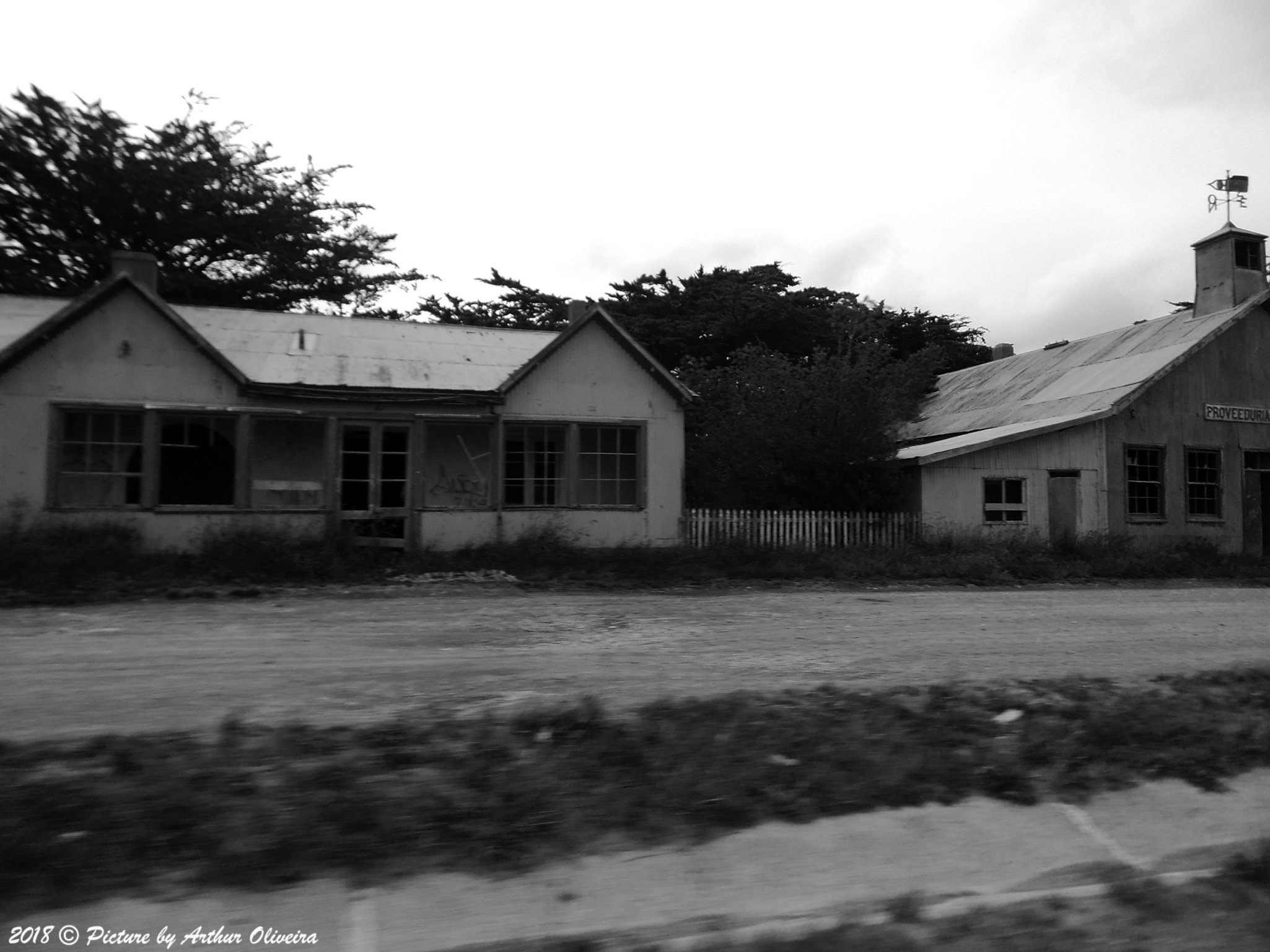
It's hard taking pictures from a moving car - Click image to enlarge!
January 7th, 2017. Fast fowarding the story by a day and a half I was now with my new russian friend, Vadim, and the guy who was giving us a ride , Cesar. I'll call him Cessar - the storyteller. The reason why I've jumped to this part is because it somehow connects to the Estancia San Gregório. The bits in between this two days are super cool, but that would make the story way too big.
So, Cesar was taking us to Rio Grande, 150 km ahead of our position in Tierra del Fuego. He used to talk passionately about his region, teaching us everything.
- This farm here is one of the largest in this region... - He said, pointing to the cluster of buildings.
- They have almost 1 million hectares, 95 thousand sheep, 10 thousand cows. - He continued.
- 1 million hectares?! - I asked. The idea seemed absurd to me.
- That's right, amigo ... the headquarters has a school, a restaurant, dormitory, everything... - He said.
I wouldn't doubt it, but the idea seemed out of reality. I had heard of farms with 100,000 hectares, but 1 million? Cesar never told us the name of that place, so the information veracity could never be confirmed, remaining a mystery.
Further on, one more story. We were passing by the Cape of Santo Domingo, a promontory that slightly penetrates into the sea, through a very high mount, a fantastic landscape looking like of a huge platform naturally sculptured like a ramp above the Atlantic Ocean.
- Look ... this is the Cape of Santo Domingo. Legends say that in times of colonization, the white man fought against the Indians, in which the Indians were cornered at the end of that ramp. With no place to run they were thrown into the sea, a fall to death. - He said.
Cesar caught our attention. He was older, a man with a few white hair and apparently in his late 50s. Porting a seriousness in his speech, we ended up not doubting his stories, accepting the facts that we would later seek to know.
The true story, however, is called La Masacre de Cabo Santo Domingo (Massacre of Cape Santo Domingo) and is the sad history of the Selknam indians genocide.
The hostility against the Selknam people began in the middle of the 19th century until the first decades of the 20th century, in the region of Magellan. The introduction of the livestock industry in the region prompted strong conflicts between natives and settlers, culminating into a war, when large landowners offered 1 Pound for each dead Selknam.
The conflict was postponed through the years and in the first decades of the 20th century happened the fateful killing, called La masacre de la playa de Santo Domingo (Massacre of the Santo Domingo beach), perpetrated by Alejandro Maclennan or Chancho Colorado, farm administrator of José Menéndez, the one who owned Estancia San Gregorio, the same I had visited with Eduardo.
The true story, different from that taught by the white men is completely different.
On the beaches below Cape Santo Domingo, shortly after pursuing the Indians, the perpetrators of the massacre invited the natives to a banquet to seal a peace agreement between the parties. During it, Maclennan serves a large quantities of wine to the Seiknam. When he found that most of them were drunk, especially the men, he got away from the beach and ordered his henchmen, hiding in the hills, to open fire on the whole tribe, killing 300 to 400 people.
I was passing through an exuberant landscape, which carries blood marks of history. A breathtaking place that many photograph, but don't even know about the horrors. Is that what we want, to share photos of beautiful places instead of history?
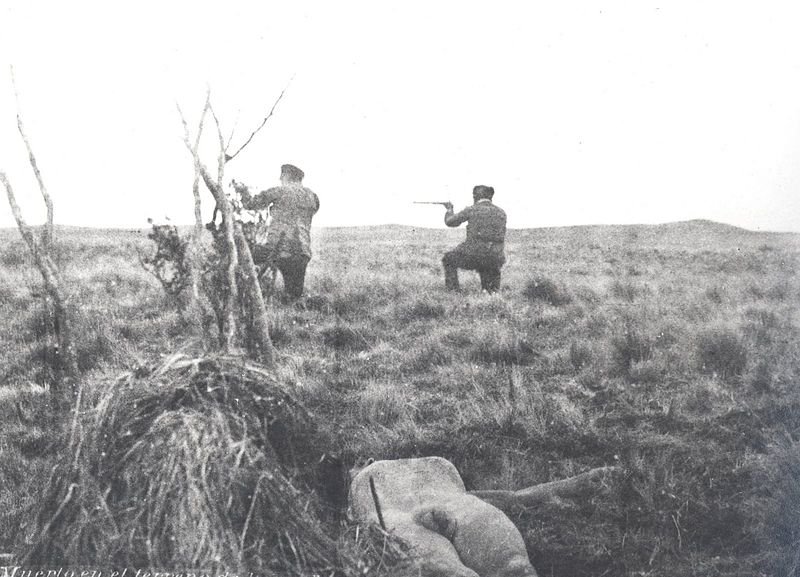
Selk’nam murdered during the aboriginal hunt by Popper. Wikipedia commons. - Click image to enlarge!
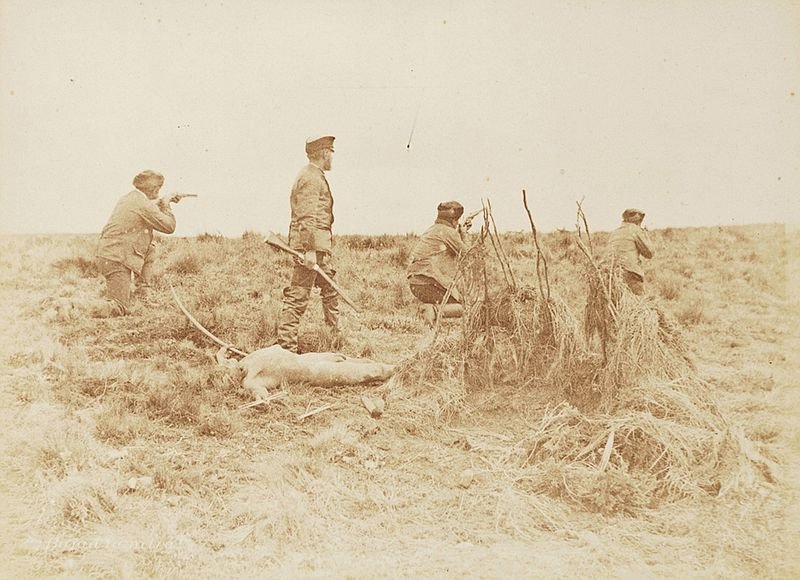
Julius Popper during one of his Indian hunts. A naked aboriginal, murdered by his militiamen, at Popper's feet. Source: Wikipedia commons. - Click image to enlarge!
In the midst of many stories and various subjects we arrived in te city of Rio Grande, the industrial capital of Tierra del Fuego. It was early evening, but the sun still gave us a little warmth. We were once again lost somewhere, the only certainty was that Ushuaia was only 210 km and the determination was to arrive the same day.
I hope you've enjoyed this less adventurous part of my trip, the main objective here was to bring a bit of awarness to NEVER forget the horrors of past times, so we don't repeat it. Even though I think genocides like this won't be repeated, as the aborigens are sadly no longer alive, it's a important reminder of what power in the wrong hands can do.
The historical facts on this story contains bits of various sources studied by me, some parts are translations and adaptations of material found online and it's all very resumed. If you want to know the full history, I'm sorry, but you'll have to read. I'll leave some sources consulted below. Cheers.
Wikipedia contributors, "Genocidio selknam." Wikipedia, La enciclopedia libre. Acessed 31 may 2018, 14:16 <Genocidio selknam>.
"ESTANCIA SAN GREGORIO" Conceio de Monumentos Nacionales de Chile. Acessed 1 jun 2018, 19:00 <ESTANCIA SAN GREGORIO>
Wikipedia contributors, "San Gregório" Wikipedia, The Free Encyclopedia . Acessed 2 jun 2018, 10:00 <San Gregório>.
Do you like to study the history of the places you visit? Drop a message down below, I'd love to hear you.
If you liked this post, please, consider leaving your upvote for a hot coffee.
~Love ya all,

Disclaimer: The author of this post is a convict broken backpacker, who has travelled more than 10.000 km hitchhiking. Following him may cause severe problems of wanderlust and inquietud. You've been warned.
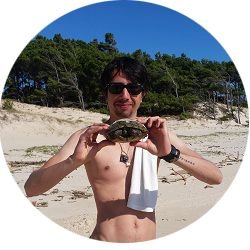
I'm Arthur. I blog about Adventure Stories, Brazil, Travel, Camping & Life Experiences.
Follow me to stay tuned for more craziness and tips.

You may also want to read:
TRAVEL: CREATIVE TIPS TO EARN MONEY - BROKEN TRAVELER EDITION
Simple Lifestyle in Valizas, Uruguay | Would you live there?
Bedside Books: Sharing Knowledge Through Fun Contests
Brazil - Bicycle Lane For What?
Monday Morning Quote: "The most fantastic things in life are on the other side of fear."
A proud member of:

